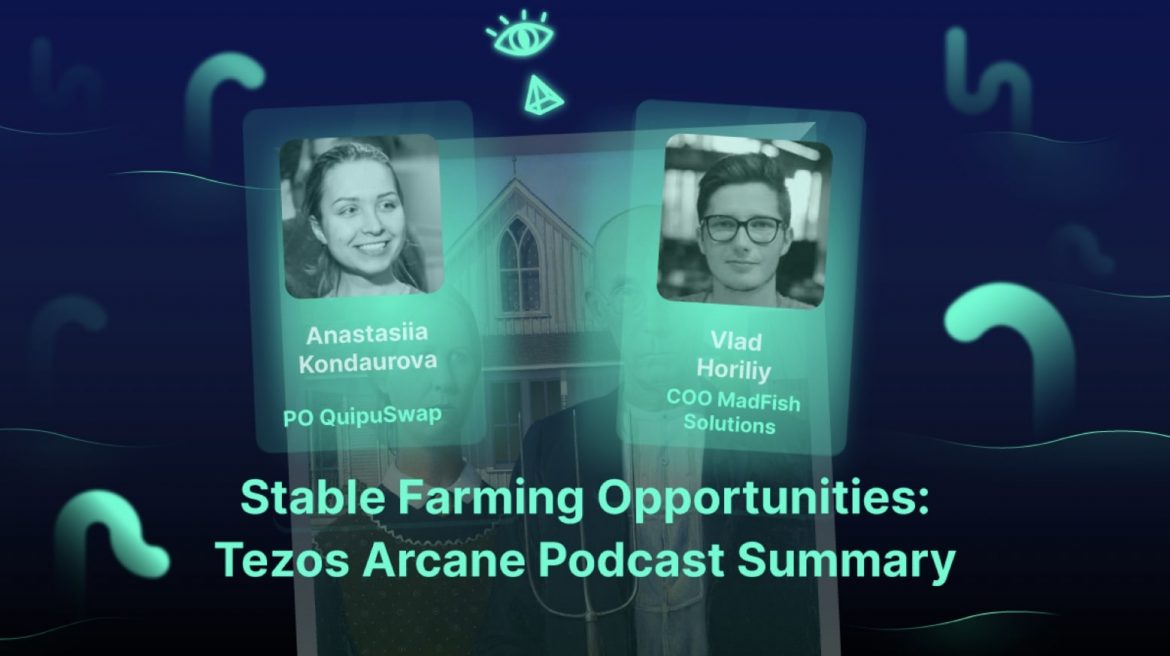Although the Tezos network is becoming increasingly robust, it remains vastly underestimated. We want to boost the ecosystem’s overall liquidity, and hence, want you to be even more efficient with your Tezos earnings.
The MadFish crew has launched a YouTube podcast where our most notorious degens share their money-making acumen with the public. The first episode pertains to stablecoins and stable farming on Tezos.
In this post, we have condensed some highlights from the stream for your perusal.
Watch the full video to learn the important details!
If you don’t know what stablecoins are – we recommend you read our educational article. In short, a stablecoin is a coin whose value is linked to a stable asset (usually the US dollar, the euro, or gold).
Stablecoins and Stable Farming on Tezos
The blockchain space contains four types of stablecoins, which are defined according to the collateral structures backing them. These stablecoin types are:
| Type | Features | Example |
| Fiat-collateralized Stablecoins | – Centralized – minted by trusted entities one-to-one; – Authorities may block stablecoins on your account; – Have reserves on a regulated account; – Protocol owners often invest part of the reserve funds in obligations for profit; – Susceptible to regulators’ fiat. | Tether |
| Crypto-baked Stablecoins | – Always overcollateralized to enable a decentralized model; – Your collateral is at the risk of liquidation. | DAI |
| Commodity-baked Stablecoins | – Similar to fiat-based but the collateral is in commodities. | Paxos Gold (PAXG) |
| Algorithmic Stablecoins | – No full collateral, but uses a set of incentives and a mathematical model instead; – Risk of eventual deprecation. | Iron Finance |
History of Stablecoins on Tezos
USDtez (USDtz) was the first stablecoin created on the Tezos blockchain, which launched in 2020. Since then, Tezos has been presented with multiple other stablecoins, including Tether (USDT).
Currently, there are 5 main Tezos-based stablecoins:
1. USDtz: The first on Tezos. A fiat-based stablecoin. Pass KYC to become a minter.
2. KUSD: Crypto-baked and overcollateralized (~180%). Has a +0.50% stability fee. Anyone can mint it. Has active DAO governance.
3. USDC: Fiat-collateralized with a small market cap.
4. uUSD: Crypto-baked and overcollateralized. Multiple synthetic assets are available and positions are more flexible due to various supported assets.
5. USDT: Fiat-collateralized. A newcomer to the network with many successful existing use cases on other blockchains.
Special mention: The Wrap protocol which allowed assets to be moved from Ethereum to Tezos. It is now known as Plenty Bridge. Multiplies the risks due to the numerous steps required.
Why Do Protocols Launch Farming?
Why does the protocol pay me rewards? This is the first question you should think about before investing. Understanding this will help you realize the reliability and “survivability” of the farming program. Is it some predictable and intelligent incentivization or just some Ponzi scheme? We can outline 4 different types of entities that incentivize farming.
- DEX stable farming. There are several ways to bring liquidity to a blockchain, e.g., bridges, exchanges, etc. When users provide liquidity, other users are able to swap. DEXs are interested in facilitating liquidity entering the network and in earning money through fees.
- Projects with their own stablecoins. A manufactured use case for using and investing their own stablecoins.
- Dedicated farming projects and vaults. Earn interest from fees.
- Scammers. They just steal your shit.
Takeaway: Before entering a farm, always ask yourself, “Why did the project create this farm, and how does it benefit?” If the answer is unclear, it probably is a scam.
How to Choose a Farm
When considering participating in a farming program, a user should be aware of several important metrics that can determine the attractiveness and the risk/profit ratio of the program. Below we have listed tier-1 parameters that need to be considered by all users before their participation.
Use this list when you assess prospective farms:
1. Protocol risks (audits, economy)
2. Token risks (utility scenarios, tokenomics)
3. Rewards (reward currency, income rates)
4. Costs, fees
5. Time (vesting of rewards, deposit lock period)
Check out this podcast to listen to an in-depth analysis of the most popular Tezos farming platforms.
Risk Factors
Like any financial operation that generates revenue, farming has some risks. Moreover, since farming is an activity inside the crypto and blockchain universe, it presents even more risks because of high volatility, legal issues, the absence of strict quality requirements for projects, etc. Below we’ll list the most important points that must be considered before participating in a program or even stablecoin farming.
This checklist will help you assess the risks associated with any farming opportunity on any network:
1. Blockchain risks (is it a time-tested and reliable network?)
2. Wallet risks (is the wallet you use secure and non-custodial?)
3. Pooled contracts risks (are the contracts audited and do they have any drawbacks?)
4. Farming contracts risks (are the contracts audited and do they have any drawbacks?)
5. Token risks (does the token have its utility and smart tokenomics?)
6. Other minor risks (e.g. the team behind, the market situation as a whole, legal issues in your country)
Please check out the full video and consider joining our next episode which will be dedicated to Lending Protocols.
Here is the full video podcast about stablecoin farming on Tezos. Watch, like, and subscribe to our YouTube channel for more useful videos and broadcasts.
Follow our Telegram and Discord accounts to keep up with the latest news and updates.

